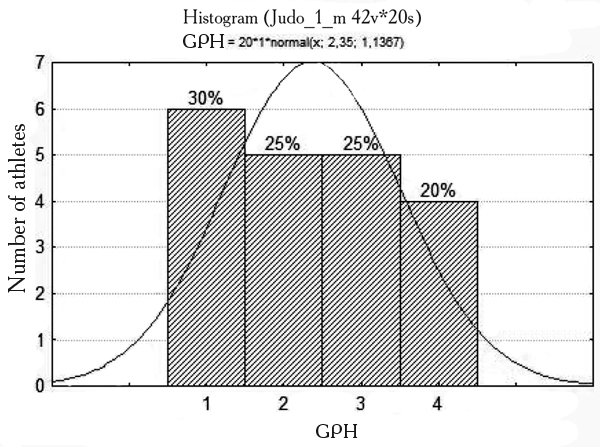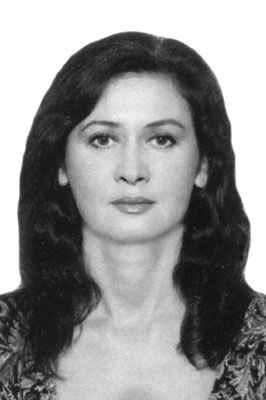The Influence of Training Experience on Morphofunctional Indices and Physical Fitness of Male Judokas Aged 8-10
Фотографии:
ˑ:
O.V. Borisenko, postgraduate
S.I. Loginov, professor, Dr.Biol.
Surgut state university of KhMAR-Yugra, Surgut
L.I. Lubysheva, professor, Dr.Hab.
Russian state university of physical culture, sport, youth and tourism (SCOLIPhC), Moscow
Key words: physical development, physical fitness, sports and fitness judo, boys aged 8-10.
Introduction. Judo is a rapidly developing style of martial arts. From the time of its formation it was aimed at spiritual and physical development of a personality based on the teachings of technical and tactical aspects and philosophy. Being a means of physical training, judo promotes the development of various physical qualities, health and ability to express personal potential. Health strengthening by means of regular training is one of the main tasks [6, 7]. At the same time, judo is a sport which needs comprehensive motor coordination, and the development of coordination abilities of 8-10 year old children is a basis of training, taking into account the sensitive period and the background (6 kyu). However, excessive physical activity may weaken a child’s body and can lead to detrimental effects. Such activity is mainly a result of the increasing competition [8] and commercialization in sports. The pursuit of many trainers for conditioning loads is often wrong, since only particular kinds of physical activity occur during contests [4, 6, 10].
Using means and methods of judo training in the frames of sports-centered physical education in comprehensive school enables significant increase of children’s physical fitness, motivation for physical education classes and reducing the risk of injury. This is proved by well-known facts concerning the high efficiency of training techniques applied in judo to improve physical fitness and functional conditions in children’s sports schools [1 – 3]. Generally, it can be concluded that in martial arts, especially in wrestling and judo, general physical fitness is a dominating factor that can result in systematic overloads of the child’s body functional systems due to sometimes inadequate health level. To clarify it we investigated physical health and fitness of judokas aged 8-10, depending on their training experience.
The purpose of the study was to analyze the influence of training experience on morphofunctional indices and physical fitness of young judokas.
Materials and methods. Twenty three 8-10 year old boys from the “Yermak” school of Olympic reserve participated in the study. Their judo training experience varied from 6 to 24 months. The study was carried out in the Research laboratory of biomechanics and kinesiology of Surgut state university of KhMAR-Yugra in March 2013; prior to this, children and parents were fully informed and the consent was obtained.
The levels of physical fitness (LPF) and general physical health (GPH) were estimated by means of the test complex of the “CosMos” expert system in accordance with the D.N. Gavrilov’s and A.V. Malinin’s recommendations [5]. The LPF was estimated by the levels of aerobic endurance, muscular endurance, flexibility, agility, coordination, rate and strength indices determined by common techniques (6-minute run test, sitting-rising test, seated forward bending, body raising, push-ups, falling ruler test, standing broad jump, shuttle run, Romberg’s test). GPH was estimated by means of the body mass index, birth-death index (vital capacity / body mass), strength index (dynamometry / body mass), Robinson index (heart rate х APsyst /100), and index of endurance at sitting-rising test) (G.L. Apanasenko, L.A. Popova, 2000) [2]. The data were statistically processed using the Statistica_6 software (StatSoft, USA). Arithmetic means and standard deviations were determined. The correlations were revealed by the one-factor dispersion analysis. The differences were considered to be significant at Student’s p-values below 0.05.
Results and discussion. The sampling distribution of young male judokas, depending on their training experience, shows that only 65% of children practice judo regularly for 11-24 months, whereas 35% of boys attend trainings for less than 10 months and have small experience.
The health level analysis revealed that the sampling consisted of 0% of children with a high GPH level, 20% of children with the GPH above average, 25 and 25% of children with average and below average GPH respectively, and 35% of children with a low GPH level (Fig.).

Fig. Sampling of young judokas by health level. The numbers correspond to the GPH level: 1 – low, 2 – below average, 3 – average, 4 – above average, 5 – high. GPH - general physical health.
The dispersion analysis revealed the relationship between the birth-death index and children’s judo experience F(5, 14) = 3.5949, p=0.0291).
This proves that even short-term physical exercises of judokas have improved children’s respiratory system. A noticeable correlation between judokas’ GPH level and training experience was revealed too. The GPH level increased with the training experience: F(5, 14) = 2.7213, р=0.0639. The time of heart rate recovery after physical tests also depended on the training experience: F(5, 14) = 3.5331, p=0,0481).
The higher training experience was shown to result in a better and faster recovery of heart rate of 8-10 year old children after physical tests.
Our investigations of physical fitness of 8-10 year old judokas showed that training experience is an important indirect factor. The short-term maintenance of membership of a sports school would reveal future talented individuals. However, children often leave fighting sport schools even after they have successfully passed control tests and semiannual examinations, that is evidenced by the questionnaire among trainers and children who had left sports schools, which was carried out by Z.M. Umarov under supervision of Yu.A. Shulik at Kuban state university of physical education, sport and tourism in 2005 [11, 12]. The answer was average of 26 % to the question ‘what is the percentage of children that continue to attend fighting sport schools after the first year?’. The interviews of children revealed that they had left sports schools because of general physical exercises (88% answers), strenuous physical exercises (98%), poor knowledge of fighting techniques (76%) and non-qualification (53%). This is the evidence that many children attend fighting sport schools for self-affirmation or just for some motor activity, not for the general physical development that occurs by itself. At the same time, the majority of trainers practice intense physical loads starting from the very beginning of training. L.P. Matveev criticized the trend to overload training by general physical exercises, harming the educational process. Particularly he said: ‘An intense training is intended for the compensation of insufficient focusing of that training, and it leads to unreasonably growing quantitative aspects of the training at the expense of qualitative ones’ [8, p. 53]. Nowadays, sports schools accept everyone and improve their health by judo methods. However, sports qualification is needed to form a promising rising generation, which requires high physical fitness level based on the corresponding level of physical health.
Conclusions. Proceeding from the analysis of the state of physical fitness, there is a lack of boys with the high level of physical fitness in the sample, while children with the above average level of physical fitness amounted to 15 %, average - 45 % and below average - 40 %. The high and low had not been allocated.
The common health index was proved to increase significantly (р=0,0639) with the growth of the judo training experience. Bigger training experience promotes better and quicker recovery of heart work after the test with physical load in children aged 8-10.
The variance analysis was used to reveal the correlation of the birth-death index and training experience of male judokas (p=0,0291), which indicates the positive effect on the children’s respiratory system from such a short-term physical exercises within judo trainings.
References
- Agashin, M.F. Methodological features of using Agashin training simulators for judokas / M.F. Agashin, R.M. Dmitriev // Fizicheskaya kultura: vospitanie, obrazovanie, trenirovka. – 2003. – № 2. – P. 30 – 31. (In Russian)
- Apanasenko, G.L. Medical valeology / G.L. Apanasenko, L.A. Popova. – Rostov-on-Don: Fenix, 2000. – 248 P. (In Russian)
- Arzyutov, G.N. Long-term training in martial arts. – Kiev: M.P. Dragimanov NPU, 1999. – 410 P. (In Russian)
- Bobylev, S.V. Integrated assessment of fitness state of judokas: abstract of Ph.D. thesis. – Tashkent: Kibernetika, 1984. – 21 P. (In Russian)
- Gavrilov, D.N. Innovation technologies of diagnosis of psychophysical state / D.N. Gavrilov, A.G. Komkov, A.V. Malinin. – SPbSRIPhC, 2005. – 43 P. (In Russian)
- Dvorkin, L.S. Physical training of 4-6-formers based on sambo wrestling classes / L.S. Dvorkin, S.V. Vorob’ev, A.A. Khabarov // Fizicheskaya kultura: vospitanie, obrazovanie, trenirovka. – Moscow. – 1998. – № 4. – P. 21 – 40. (In Russian)
- Dvorkin, L.S. Power training of young athletes / L.S. Dvorkin, N.I. Maladinov. – Yekaterinburg: publ. h-se of UralSU, 1992. – 80 P. (In Russian)
- Igumenov, V.M. Martial arts: teaching aid / V.M. Igumenov, B.A. Podlivaev. – Moscow: Prosveschenie, 1993. – 240 P. (In Russian)
- Matveev, L.P. On the problems of theory and methods of sports training / L.P. Matveev // Teoriya i praktika fizicheskoy kultury. – 1969, № 4. – 49-53. (In Russian)
- Shestakov, V.B. Theory and methodology of children’s judo / V.B. Shestakov, S.V. Eregina: OLMA-PRESS. – 2008. – 216 P. (In Russian)
- Shulika, Yu.A. The motivation aspect of ensuring mass physical culture at comprehensive secondary school /Yu.A. Shulik, T.A. Gayduk // Modern issues of development of physical culture and sports biomechanics: Proceedings of the intern. scient. conf. – Maikop, 1999. – P. 166-171. (In Russian)
- Shulika, Yu.A. Judo: first lessons. Rostov-on-Don / Yu.A. Shulik, Ya.K. Koblev, A.A. Maslov. – 2006. – 30 P. (In Russian)
Author’s contacts: apokin_vv@mail.ru




 Журнал "THEORY AND PRACTICE
Журнал "THEORY AND PRACTICE